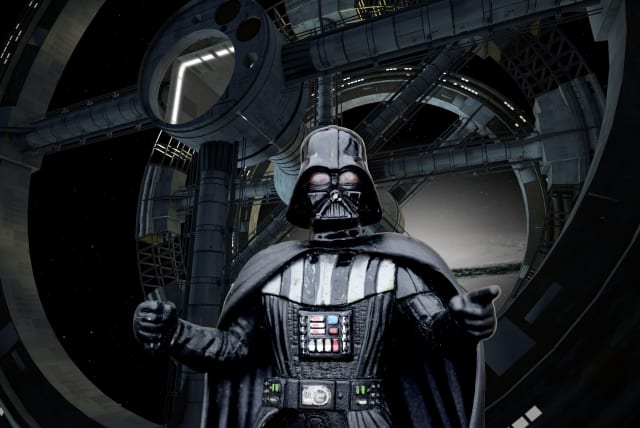What animals are kosher in the ‘Star Wars’ galaxy?

What would a Jewish Jedi eat? It turns out, there are only three kosher animals known to exist. Some were confirmed by film director George Lucas himself in an interview.
When you watch the Star Wars films, you might wonder: What would a Jewish Jedi eat? Or specifically, what beasts in a galaxy far, far away are kosher? As we analyze the different alien monsters and critters in the universe, we find that only three kosher animals exist in the known galaxy. Some were confirmed by film director George Lucas himself in an interview.
Mammals
For a mammal to be kosher, it must have two features – cloven hooves and chew cud (ruminate). Your first thought is the elephant-sized bantha, as it resembles an ox. Cattle, which we are familiar with, are kosher and widely eaten on planet Earth. Banthas inhabit the desert planet of Tatooine and are used by Tusken Raiders as mounts.
The bantha’s blue-colored milk is the first food item that we see in the series, served in a cantina in the franchise’s 1977 debut episode, Episode IV: A New Hope. However, the animal is not kosher, since a close inspection reveals that the bantha doesn’t have cloven hooves. In addition, bantha milk is not kosher – just like camel milk isn’t, as the status carries over to any dairy product extracted from the respective animal. We don’t know if the bantha ruminates, but it is eliminated in any case.
However, a shofar made of bantha horn would probably be incredible to possess or for your local rabbi to blow.
There is a tusked animal which the Ewoks hunt on the forest moon of Endor in Episode VI: Return of the Jedi. The smell of this unidentified species attracts Chewbacca, who is a Wookie, a bear-like species. This eventually gets the heroes of the Rebel Alliance captured – Luke Skywalker, Han Solo, C-3PO and R2-D2. The unnamed animal has hooves, but Lucas said that it doesn’t ruminate. So it’s not kosher, either.
Fish
Fish are kosher if they have fins and scales. We notably saw many fish when we got a glimpse of marine life on the planet Naboo in Episode I: The Phantom Menace when Jedi masters Obi-Wan Kenobi and Qui-Gon Jinn are taken by Jar Jar Binks to his underwater hometown, Otoh Gunga. The amphibious Gungans dwell in a submerged Atlantis-like city beneath Lake Paonga.
The oopee sea killer, also known as gooberfish, has evolutionary traits drawn from multiple aquatic earthly animals, including what looks like a crustacean’s exoskeleton. The Jedi masters encounter this aquatic denizen when it attacks their tribubble bongo, a bio-engineered submarine.
Since the oopee sea killer has a shell instead of scales, it cannot be considered kosher. Interestingly, however, there is a loophole. Some rabbis have ruled that swordfish are kosher when they are juvenile, since they have scales at that stage in life. But the adults aren’t kosher, as they lose the scales. But Lucas said that the juvenile oopee does not have scales, which means it is not kosher at any stage of its life.
The oopee sea killer that attacks the Jedi’s submarine is then eaten by the much larger sando aqua monster, and Qui-Gon remarks, “There’s always a bigger fish!”
The sando aqua monster has a cat-like or (sea lion-like) appearance and is a gigantic apex predator. In the video game, it is described as a marine mammal and not a fish. We will assume that the senior Jedi master was either not well versed in Naboo marine zoology, since it was probably his first visit to Otoh Gunga, or it could be a mere “metaphorical reference.” Either way, the sando aqua monster neither has the cloven hoof feature if it is a mammal nor does it have fins if it is a fish, so let us rule this out anyway. This questionability reminds us of the platypus, which baffled scientists and rabbis when it was first discovered in Australia. It is an aquatic mammal whose biological traits were perplexing due to its duck bill and the fact that it lays eggs.
There are many fish species in the Phantom Menace and the aquatic planet of Ahch-To, where Luke Skywalker was hiding while in exile in Episode VIII: The Last Jedi. Who knows if a few among the many unnamed species we saw might be kosher.
Birds
For a bird to be kosher, it has to have these traits: It should have an “extra” toe, a crop, and/or a gizzard that can be peeled; and it must not be a bird of prey.
We see ducks in Episode I on the planet Coruscant. They swim in the Solleu River in the capital city of Theed. Captain Panaka mentioned them in a scene that introduces the famed droid R2D2 when he said, “If we can’t get the shield generator fixed, we’ll be sitting ducks.”
This confirms that the duck is one earthly creature that exists in the Star Wars canon. Initially, one would assume that if it’s kosher on Earth, then it will automatically be kosher on another planet as well.
A peek into earthly history shows that when Europeans first landed on American shores in the Age of Discovery in the 15th century, they found a whole new world of animals that were only known to Native Americans, and there was a debate about the kosher status of many animals. Some of them had similarities to Old World livestock, and the debate about “tradition” arose. Most probably, like the muscovy duck, the kosher status of the Coruscant duck will be debated for generations of spacefarers and is therefore inconclusive at best.
Then there is the nuna bird, or swamp turkey. This is one of the mobster Jabba the Hutt’s pets and is native to the swamps of Naboo. As of the most recent series, nuna birds and their eggs have been exported, farmed and eaten throughout the galaxy. It has three toes and simply cannot be a bird of prey because it is so docile and easy to domesticate. However, it is a reptavian – possessing traits of both reptiles and birds. Since no reptiles are kosher, even if the nuna has a peelable gizzard, the debate about its reptilian traits will arise. Therefore, it is most probably not kosher or is inconclusive at best.
When you see the porg on Ahch-To, your first thought would probably be how someone would consider consuming something so cute! The porg is not kosher, as it is a bird of prey. Porgs dive to hunt for fish and shellfish. Porgs are not kosher in the same way that seabirds like storks, pelicans, penguins and puffins are not.
There are also chickens in the Star Wars universe. In Episode VI, we see Ewoks farming Endorian chickens or tip-yips. In the 1984 made-for-TV film Caravan of Courage: An Ewok Adventure, we see that they resemble the real-life breed called Silkies, which are named for the fluffy, crest-like plumage on their head. They are (most probably) kosher.
Most of the creatures that we have seen so far in the Star Wars mythos cannot be considered kosher (although it is possible that a couple of birds and fish might be). So, practicing Jewish space travelers/Jedi would probably have a hard time finding meat options and need to stick to vegetarian items. That probably isn’t an issue, since there is an abundance of plant life in that distant galaxy.
But, as more creatures in the bestiary make an appearance in Mandalorian Season 3, which comes out in March, we can only wait to see what new species abound and if any possess the kosher traits that we look for on Terran menus. ■
Jerusalem Post Store
`; document.getElementById("linkPremium").innerHTML = cont; var divWithLink = document.getElementById("premium-link"); if (divWithLink !== null && divWithLink !== 'undefined') { divWithLink.style.border = "solid 1px #cb0f3e"; divWithLink.style.textAlign = "center"; divWithLink.style.marginBottom = "15px"; divWithLink.style.marginTop = "15px"; divWithLink.style.width = "100%"; divWithLink.style.backgroundColor = "#122952"; divWithLink.style.color = "#ffffff"; divWithLink.style.lineHeight = "1.5"; } } (function (v, i) { });

